
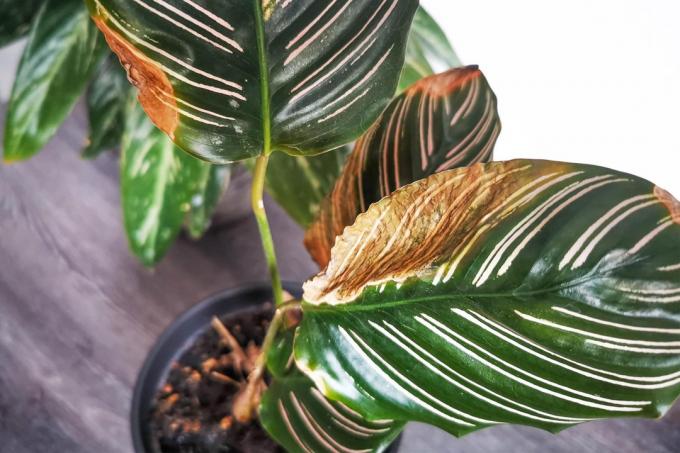
Table of contents
- Cut off brown leaves
- find cause
- Change location or optimize
- change watering behavior
- increase humidity
- reduce nutrient supply
- frequently asked Questions
The foliage of a calathea, also known as a basket marante, has its price. And that doesn't mean the purchase price. The tropical plant wants to be cared for and feel like in the rainforest at home. She expresses her dissatisfaction with unfavorable living conditions with brown leaves.
Cut off brown leaves
Brown leaves are about to dry up or have already dried up. They no longer have any ornamental value, but force themselves on the eye. Recovery is impossible, but energy still flows to them until they dry up completely. Promptly remove brown leaves at the base. The energy saved will flow into the formation of new leaves and quickly compensate for the leaf loss suffered.
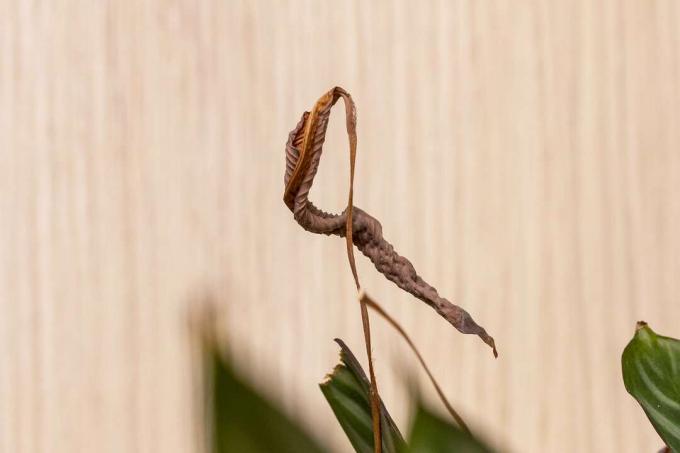
find cause
Removing the brown leaves has restored the beauty of the calathea plant. But for how long? Because if calathea leaves turn brown prematurely, there must be a reason for it. If this is not discovered and eliminated, it can continue to work and the problem is only solved temporarily. Experience has shown that the cause can be found here:
- too much sun exposure
- draft
- dry earth and/or air
- over-fertilization
A notice:
On each calathea, occasionally some of the older leaves will turn brown. This is a completely natural process and you don't need to worry.
Change location or optimize
Take a look at the original living conditions of this plant to know roughly how to optimize its location in the room. As a forest plant, the calathea grows in the shade of large trees. She doesn't get direct sun, not even plenty of light. The air around them is characterized by consistently high humidity.
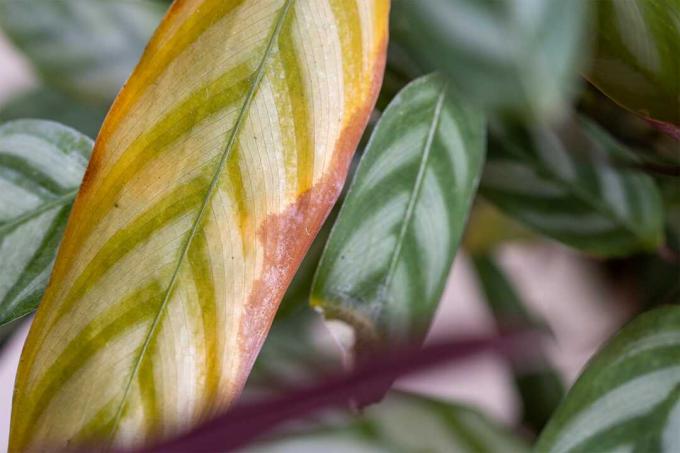
- Never expose Calathea to direct sun
- the south window is unsuitable
- Shade other window sills with curtains, awnings or roller blinds
- Don't put the pot in front of an open window
- choose a sheltered place
change watering behavior
The first pillar of an optimal moisture supply is the need-based watering. Never let the potting soil dry out. But also avoid waterlogging, as this damages the roots of the plant. The safest way to do this is if you water the calathea with small amounts of water, increasing the number of waterings. If you find out when researching the cause that the soil is dripping wet, you should take a watering break or even repot the plant in drier soil. Especially in winter, it can take too long for wet soil to dry sufficiently on its own.
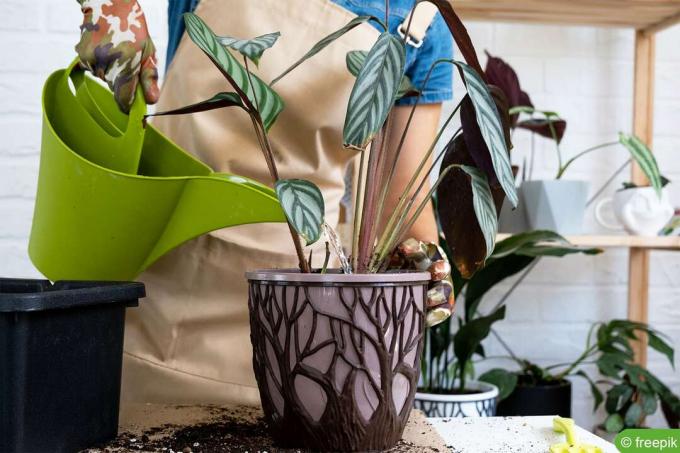
increase humidity
Keeping the humidity high in this country is not easy. It becomes a challenge in winter when the heaters are running at full blast and ensure that the air is dry. Still, try to provide your calathea with as much moist environment as possible.
- move away from the heater
- Spray leaves regularly with water
- Place bowl of water next to pot
- possibly. Use an electric humidifier
Tip:
A humid conservatory or greenhouse that is heated comes closest to the rainforest environment. If you have such a location to offer your Calathea, you should not hesitate to move there.
reduce nutrient supply
Over-fertilization shows up first with yellow, later brown leaves on the calathea, which then dry up. This is because the calathea is treated like other houseplants out of ignorance. Their nutritional needs are much lower. In the forest, the soil is not a paradise either, since most of the nutrients are taken up by competitive trees. Repot an oversupplied calathea immediately into fresh substrate and then fertilize it after several weeks as follows:
- only fertilize in the growing season from April to September
- fertilize once a month, at most every 14 days
- Use liquid fertilizer
- reduce the recommended dosage by half
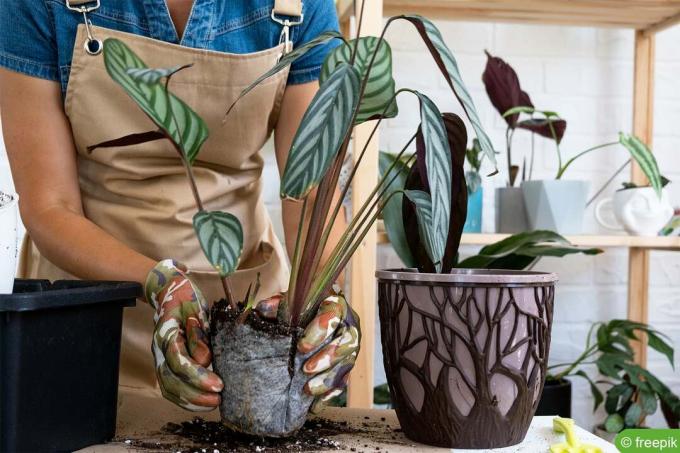
Tip:
The old soil doesn't need to be discarded, but can be used for repotting other houseplants that are known to be nutrient-loving.
frequently asked Questions
In addition to quantity and frequency, the water quality also plays an important role when watering. Since the calathea a slightly acidic pH preferably between five and six, it must not be too hard. Therefore, water with soft rainwater or decalcified tap water. The irrigation water should not be cold, but slightly warmed up.
Don't worry, brightness does not lead to brown leaf tips, but direct sunlight. You can roughly tell how much light a variety needs by looking at the foliage. The more colorful and variegated it is, the more light you should give her. Otherwise the attractive leaf markings will fade.
At the Korbmarante you can aphids and spider mites occur, especially when the living conditions of the plant are not optimal. If the infestation is severe and long-lasting, the plant becomes so weak that it develops more and more brown leaves. But both pests cannot be overlooked because they are numerous or small on the leaf stems form cobwebs, so that brown leaves can be avoided by timely control measures can.
 Maike
Maike
Learn more about houseplants

16 cat-friendly houseplants
If you share an apartment with a cat, you should not have any poisonous indoor plants, because cats occasionally eat the greenery. There are many cat-friendly houseplants that are harmless and can recover quickly once a cat has bitten them.

Monstera droops leaves: what to do?
Its serrated leaves make the Monstera one of the most popular indoor plants. But what can be the reason for it letting the leaves droop, and what can you do about it?

Water houseplants properly 15 tips for potted plants
Watering indoor plants properly sometimes turns out to be more difficult than expected. There are certain points you need to keep in mind when watering your indoor plants so they can show off their full glory. 15 tips on the subject can be found in this guide.

Efeutute, Epipremnum aureum: care from A - Z
The ivy or Epipremnum aureum is one of the most popular houseplants par excellence and is also ideal for people without a green thumb. You can find out how to care for the plant from A - Z here.

Christmas Cactus Losing Buds: 6 Reasons & Solutions
The Christmas cactus is a real feast for the eyes in the living room from late summer with its beautiful flowers. Unfortunately, it often happens that the houseplant loses its buds. Find out here what causes the buds to fall and how you can counteract them.

Purpurtute, Syngonium: care and propagation
The purple mare (Syngonium) is known as a fast-growing climbing plant with pure green, mottled, reddish or lightly variegated leaves. The numerous species not only differ in color, but also in the shape of their leaves, which changes with age.


